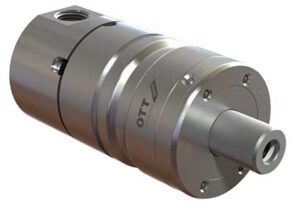For spindles that utilize through-tool coolant, rotary unions can be a common cause of failure. And yet, they are equally overlooked — few people include rotary unions on their periodic inspection routines.
Rotary unions are specialty joints designed to allow connection of a stationary to a rotating piece of equipment. In spindle applications, rotary unions allow for the connection of coolant tubes, mounted to the drawbar and interlocked with the internals of the rotary union (rotating). The housing of the rotary union attached with the hydraulic and coolant hoses are stationary (non-rotating). The drawbar with the spindle shaft is rotating thus allowing coolant to flow through the union through the drawbar and to the machining operation/part being machined.
The primary reason for failure in rotary unions are the seals. There are coolant tube seals, hydraulic seals, and face seals for the coolant through. Spindle failure is sure to follow if the seals are worn over time.
Rotary Union Lifespan Considerations
 We reached out to Harold Goellner, Product Manager/Senior Engineer at Advanced Machine and Engineering Co., our colleague, and an expert on rotary unions and tool clamping systems. We asked him about the types of scenarios and conditions that impact a rotary union’s usable lifespan. Naturally, the two most important things to a rotary union’s lifespan are the RPMs that the spindle (and therefore the union) operate at, and the through pressure of the coolant.
We reached out to Harold Goellner, Product Manager/Senior Engineer at Advanced Machine and Engineering Co., our colleague, and an expert on rotary unions and tool clamping systems. We asked him about the types of scenarios and conditions that impact a rotary union’s usable lifespan. Naturally, the two most important things to a rotary union’s lifespan are the RPMs that the spindle (and therefore the union) operate at, and the through pressure of the coolant.
Harold also shared a variety of other environmental and usage-based conditions that can negatively impact rotary union lifespan. They include:
- Side-loading of supply lines connected to the ports, which can cause union runout
- Installation of unions with mounting surfaces that do not match the spindle’s specifications, which can cause runout
- Deadheading of the tool which blocks coolant flow through the drawbar, even if temporary
- Use of improper or insufficient filtration, making internal seals and bearings vulnerable:
- Typically recommended filter grade is 50 microns or less
- Filter media purity is laid out in ISO 4409 -/17/14
- Consider the type of material being machined (e.g. glass and cast iron are more abrasive than other types, require finer filtration)
- High running temperatures
- Running at RPMs in excess of the union’s specifications
- Operating with improper hydraulic and coolant pressures, either under or over the defined ranges
- Allowing/causing pressure spikes or pulsation, which can cause shock in contact seals
- Improper residual pressure on hydraulic seals during rotation, which causes premature seal wear
- Use of improper coolant types
Leaky Unions Do Not Necessarily Mean Defective Unions
It’s important to note that rotary unions leak as part of normal operations. The presence of a certain degree of leakage is normal and expected, and not necessarily indicative of a defective rotary union. This is why, when testing spindles in the shop, we at GTI pressure check rotary unions and verify against manufacturer specifications. We also offer leakage sensors, which constantly measure leakage rates and trigger alarms when rates exceed normal. Some rotary unions offer threaded drainage ports to route leakage back to the hydraulic and coolant tanks to prevent drainage into the spindle.
It’s important to keep an eye on your rotary unions, including with leakage monitoring. If caught and replaced before failure, there is significant cost savings. In most cases, a failed union will allow coolant contamination to enter the spindle/spindle bearings and will then necessitate a full spindle repair/rebuild in addition to replacement of the union.
Special thanks to Harold Goellner, Product Manager/Senior Engineer at Advanced Machine and Engineering Co., for his contributions to this blog.
